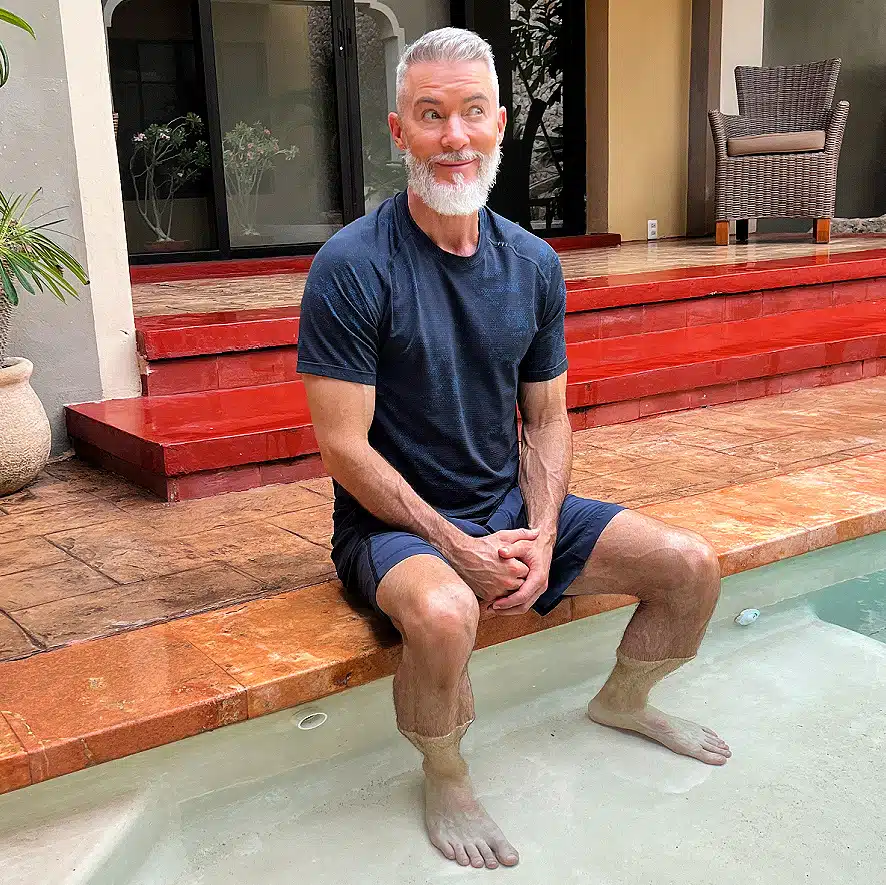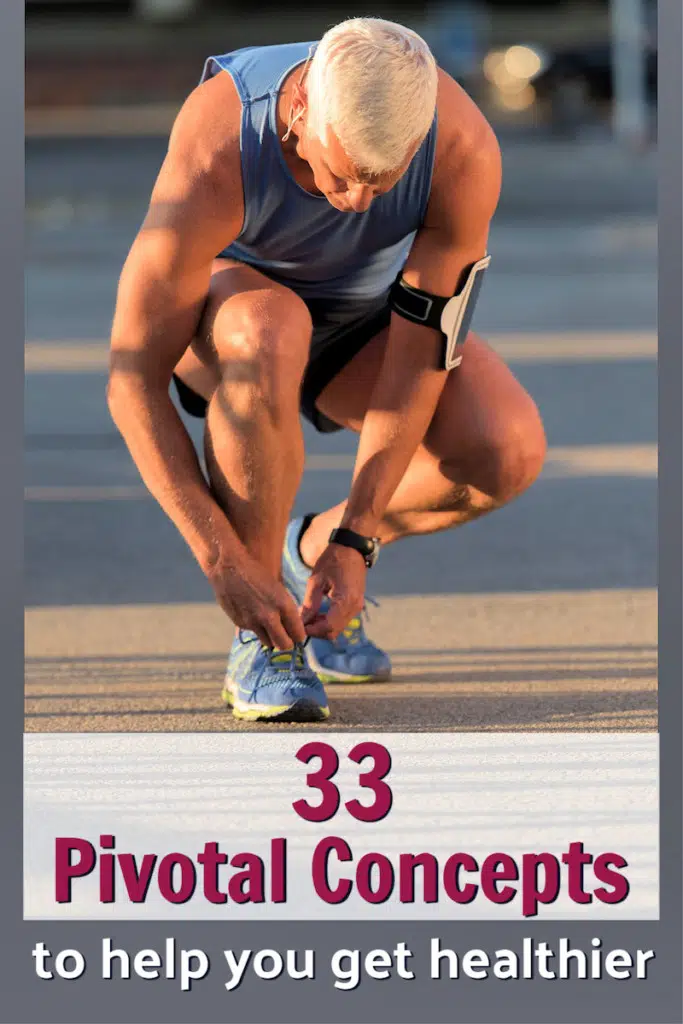Getting into shape as a golden-ager differs from getting into shape in your twenties. You’ll probably need to develop healthier habits to wake each morning looking good and feeling strong. Here are the fundamentals you need to know so you can thrive with robust physical health and a meaningful emotional life after the age of 50. Video is also included below.
Are You a Golden Ager?
A golden-ager is a person of mature years who possesses more wisdom than they had in their youth.
While a “senior” is someone specifically over the age of 65, a golden ager has a broader definition. A golden-ager refers to anyone who feels mature and senses that they are likely within the post-middle of their lifespan.
To integrate healthier habits into your lifestyle as a golden-ager, you’ll need to know the meaning of some often-used fitness terms and concepts. This glossary of ideas, listed alphabetically, will help significantly.
50
The milestone age of 50 is recognized as pivotal for many people as it’s the age when one begins to notice that health and appearance can deteriorate quickly if lifestyle habits are subpar.
Aging into Being a Successful Golden Ager
Aging is the process of becoming older. It can be done successfully. Though aging might be unavoidable, accelerated aging is avoidable.

Ancestral
Human beings lived a particular way on the planet for over 160,000 years.
Our brains and bodies adapted accordingly.
Only recently – in the last 200 years – our daily lives have changed radically.
These recent disruptions occurred so quickly that we haven’t physically evolved to match the changes. For this reason, referencing positive ancestral habits can sometimes be helpful.
Andropause in the Male Golden Ager
Andropause is a collection of (sometimes reversible) symptoms and biological events that can occur in mature men.
Ankle Weights
Ankle weights are exercise accessories that provide a more straightforward, less-expensive way to bolster equipment within a home gym area. Appropriately used, ankle weights can be highly effective.
Annual Check-Up
Seeing your medical doctor for an annual check-up continues to be important – because it establishes a baseline from which you can discern whether health is going up or down.
Results from your blood lab work – fasting glucose, for example – provide valuable clues to what’s happening inside your body.
Antioxidant
Free radicals are “bad molecules” produced inside your body when you digest food or are exposed to specific environmental stressors. High levels of these compounds cause bodily harm and are linked to multiple illnesses – including cancer, heart disease, and diabetes.
Antioxidants are helpful molecules that neutralize free radicals. Antioxidants are found in food, particularly vegetables and fruits.

Autoimmune
Autoimmune is an adverse health condition that humans are experiencing with greater frequency. It happens when the immune system fatigues – and, therefore, loses the nuance required to discern healthy cells from unhealthy cells.
The solution to reversing autoimmune symptoms is to improve cellular health – and, so far, an anti-inflammatory diet appears to be among the more effective ways to achieve this.
Balance Is One of the Top Healthier Habits
Physical and psychological balance is essential for self-improvement for those over fifty.
Balance can mean developing the physique symmetrically – with a posterior chain as developed as the anterior muscle chain (the back and front muscles of the body, respectively) – and a lower body that is as strong and flexible as the torso (and vis versa).
Balance also refers to the ratio of adventurous challenges one undertakes to make life textured and memorable, juxtaposed with enough self-care and relaxation to soothe an anxious central nervous system.
Balancing work and play is both an art and a science.
While imbalance tends to create health challenges, balance tends to help health to thrive.
Before Bed / After Awakening
We tend to think of our lives as a reflection of key “Oscar moments.” However, our lives are ultimately built from small, daily habits.
They are the activities we do most often – that, over time, impact the reality of who we become.
Among the most impactful periods are (what we do and think) before bed and (what we do and think) after awakening. A brilliant nightly ritual and a fantastic morning routine can change your whole life for the better.
Belly Bulge / Belly Fat
Losing belly fat after 50 is a bit trickier but entirely possible.
Consuming fewer calories than you expend through physical activity is still an essential weight-loss method.
However, after 50, tracking inflammation becomes a factor, too. The modern diet irritates most bodies, and the human body responds protectively to persistent irritation by padding internal organs with fat. Hence, it can be helpful to understand the difference between visceral and subcutaneous fat.
Being Barefoot Is a Healthier Habit!
Feet have muscles, too. The human foot contains 29 muscles that need to be strengthened. Because feet form the foundation of the human body, their health can impact everything else (directly or indirectly). For this reason, it can be helpful to spend some time barefoot. Not only does it ground your body’s electrical current, but it keeps the Achilles tendon from becoming too compressed.
If you’ve become accustomed to wearing shoes with a higher heel or thicker sole, it’s best to start gradually when exercising barefoot or with a low-rise shoe – this will give the muscles and tendons in your feet a chance to acclimate. Being barefoot also allows you to practice centering your weight (most people tend to roll their body weight over to one side of their foot) and to practice moving without rotating your feet and thighs outward (a common problem today).
Body Composition
The ratio of muscle to fat in your body is your body composition. It’s reflected as a percentage. For example, men who keep their body composition at 14%, and women who are at 21%, are generally considered to be in good shape. Scales are often not the best way to determine fat loss because they don’t distinguish water weight or gains and losses in muscle tone. Body composition tests are better. Using a tape measure is better. Even monitoring how your favorite clothes fit is a more accurate method of fat loss.
Cheat Meal
When switching to a lower-carbohydrate lifestyle diet, it can be helpful (in some circumstances) to periodically top-up glycogen levels by eating a meal with carbs.
Checklist
Many people find that it’s challenging to get more fit when disorganized. Getting organized helps you to use your energy more productively and spend time more wisely. Customized checklists can be enormously helpful when trying to adopt new, healthier habits.
Circuit Training Is Helpful to the Golden-Ager
The most intelligent workout is no-good if, in the end, you’re not going to stick with it. The genius of circuit training is that it can be enormous fun. Therefore, it’s more effective because the exercise style you’ll actually do is usually the best method.
A popular circuit training style is three circuits, each containing five exercises.
You do all exercises consecutively in the first circuit, take a 3-minute break, and then do it all again. You do an entire circuit 3 times before moving on to an entirely new circuit.
Core
It turns out that a strong pelvic floor is more important than we ever thought. Most people need to spend more time regularly developing their lower abdominal and glute muscles. Doing so will help the pelvis place properly, thereby protecting the bladder and lower back. Besides, few things are more visually appealing than somebody walking around with a super well-conditioned core.
Cross-Training Is a Healthier Habit
Cross-training means switching to a different type of exercise right before your body would otherwise begin to plateau.
The human body adapts to movement patterns quickly so that you can keep your body – and metabolism – responding by employing variation.
Steady-state cardio, anaerobic sprinting cardio, strength training, mobility workouts (stretching, Pilates, swimming, yoga), and competitive sports (tennis, soccer, hockey, basketball, martial arts) are examples of the types of workouts that can be interspersed within a typical month.
Digestion
It’s not what you eat; it’s what you absorb. Excellent digestion significantly affects how you look and feel because it allows your body to assimilate the micronutrients from your diet effectively. Additionally, the gut microbiome plays an essential role in your overall health (you want more of the beneficial bacteria and less of the harmful bacteria). Anything that benefits your gut is among the top healthier habits and crucial to the well-being of the golden-ager.
Gratitude and Enthusiasm
What can you do to generate more feelings of appreciation each day? What would help you to feel excited about life again?
Thought replacement is the act of objectively witnessing the thoughts that play inside your head and replacing the negative ones with those that are more helpful.
Green Smoothie (Micronutrients and Co-Factors in Vegetables Help the Golden-Ager)
Vegetables are a true game-changer, and most people consume fewer vegetables than they realize. One of the easiest ways to increase your daily vegetable intake is with the blended green smoothie. But it has to be made correctly.
Home Gym Area
Working out at home requires less space and equipment than many people realize. If possible, it’s a good idea to have an area at home where you can exercise – for those days when you’re too busy to plan a fitness excursion.
Lifespan VS Longevity (the Golden Ager Has Important Choices to Make)
In theory, the longer you are here on the planet, the more chances you’ll have to make a positive impact. Lifespan refers to the number of years you are alive. Longevity refers to that specific part of your lifespan where you can experience joy and be healthy, relevant, and mobile.
Men’s Health and Women’s Health
Men’s health refers to those interventions that seek to provide solutions to the challenges men experience to their well-being, including nutrition, supplementation, hormonal changes, risk of accelerated aging, mental health, muscular development, and physical conditioning.
Similarly, women’s health represents those ideas that have been proven to help women thrive.
Midlife and Post-Midlife (Life as a Golden-Ager)
Midlife refers to that period within your lifespan that, statistically, represents the typical “halfway mark.” Post-midlife refers to that the time period that likely represents the final third of your life.
While many people enter these phases of life on autopilot – trying not to think consciously about their own mortality – midlife and post-midlife are, in fact, ideal times to intentionally evaluate your priorities and to identify those activities (and people) that bring you the most opportunities to feel joy.
Perhaps most importantly, after age 50 is the best time to determine what role excellent health might play in actualizing your best life from this point forward.
Outdoor Activities
Most people spend way too much time indoors.
People in developed countries spend 87% of their total time indoors, which doesn’t even include the time spent enclosed within a vehicle – at least an additional 6%.
Indoor air quality is often worse than outdoor air. Human beings have evolved to need fresh air and sunlight to thrive – we are not an indoor species. A once-a-month hike is better than nothing, but still not enough. Get outdoors during your lunch hour if you can. If you cannot do an intense workout, then at least go for a long walk. Too warm? Wear sunscreen and a hat. Too cold? Pile on the coats, gloves, and scarves.
Pilates Benefits the Golden Ager Especially
The Pilates method of body conditioning prioritizes proper technique and is considered by many to be ideal for mature athletes – as the calisthenics emphasize core strength, joint mobility, muscular flexibility, balance, and spinal health.
There are many ways to do Pilates, from on your mat at home to a private trainer or classes that use various equipment such as a reformer, trap table, tower, or chair.

Positive Psychology Is Among the Top Healthier Habits
No conversation about mental health and self-improvement is complete without including the topic of Axis II.
We are currently within an epidemic of poor mental health, including the rise of Cluster-B Axis II personality disorders – people challenged with self-absorption (narcissistic styles of behavior) or habitual anger (borderline styles of behavior).
People with Axis II are usually keeping a big secret about themselves from themselves.
But what’s most concerning is not people with Axis II but those who enable them.
Identify any person with Axis II, and you’ll often also see a group of people surrounding the person. This tribe subliminally enables and reinforces that person’s behavior and false self-image:
- If you happen to be a person currently challenged with Custer-B Axis II, individual and group therapy can be helpful. Also (though making yourself the center of attention might dispel anxiety in the short-term), in the long-term, you might better heal your psyche by practicing not being the center of attention – by listening more than talking and by replacing negative thoughts with positive ones.
- If you’re a person who is currently enabling a Cluster-B individual, you might ask yourself why and consider that you’re probably not doing the world any favors. Consider, instead, surrounding yourself with positive people that nourish you in healthier ways.
Chip Conley, a thought leader on meaningful aging, states:
“When someone actually shifts their mindset from negative to positive, they gain 7.5 years of additional life, which is more additional life than if they actually stopped smoking at 50 or started exercising. We don’t talk about old-growth humans like we do old-growth redwoods, but the reality is we can grow holistically – moving from the playing field of the body to the playing fields of relational, soul, heart, and cultural intellect.”
But how do you best prepare for that new habit?
A wise place to start is to ask yourself, “if I were to get in my own way, how would I do it?”
Nobody knows you better than you do. Your first gut-instinct answer to that question is usually correct.
Once you know what specific ways you might be tempted to sabotage yourself, the solutions become much easier to identify.
Preparation is the most often skipped stage of change. And therefore, the primary reason that many people fail to create new good daily habits that last.
Many people believe that the desire to change is enough to get them started, and they don’t realize that preparing for change is a critical part of the process:
Firstly, preparation helps people set achievable goals. “Preparation” involves gathering information, identifying resources, and setting realistic goals that are specific and measurable.
Secondly, preparation helps people build confidence. When people have a clear action plan, they feel more confident in their ability to change. They know what steps to take and have a clearer idea of what to expect.
Thirdly, when people prepare for change, they can anticipate potential obstacles that might prevent them from achieving their goals. They can then develop strategies to overcome these obstacles, which can help them stay on track and avoid setbacks.
Finally, preparation helps people create a support system. When people prepare for change, they can identify the people who can support them in their efforts.
Glossary of Fitness Terms Every Golden Ager Needs to Know (and the Context in which They’re Used)
This glossary is an alphabetical list of fitness-related terms or health concepts with brief explanations to help benefit the golden-ager.
The healthier habits that seem to make the most difference for the golden-ager are anti-inflammatory nutrition, strength training, and conditioning – including muscular flexibility and joint mobility – habitually positive thinking, and good sleep hygiene.
If you’re a golden-ager on an adventure to become healthier than ever, you’ll need the proper preparation, knowledge, and motivation.
Life gets better when you can integrate healthier habits into a typical week as a golden-ager. The above glossary of ideas, fitness terms, and concepts will help significantly.

Additional Sources on Healthier Habits and Life as a Golden Ager:
Antioxidants for Mature People – https://www.ncbi.nlm.nih.gov/pmc/articles/PMC5745491/
Benefits of Resveratrol – https://examine.com/supplements/resveratrol/
Time Spent Indoors VS Outdoors – https://snowbrains.com/brain-post-much-time-average-american-spend-outdoors/
